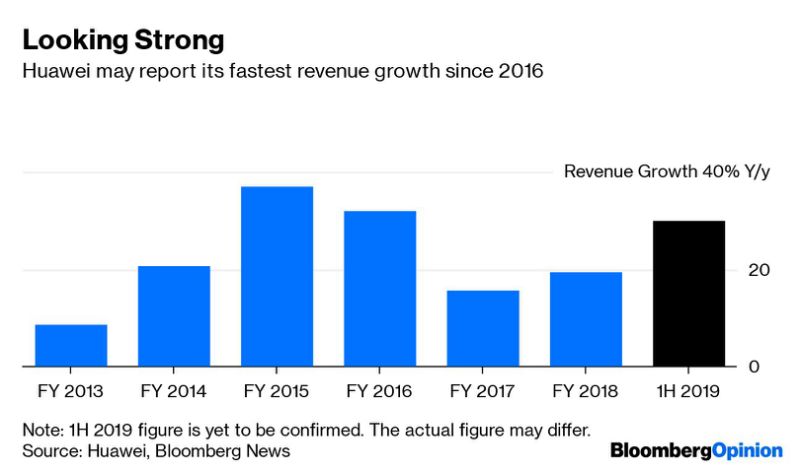

(Bloomberg Opinion) — Things aren’t so desperate for Huawei Technologies Co. after all.
Just over a month ago we were told that the Chinese electronics giant was hunkering down for a drop of as much as 60 million units in overseas handset shipments this year. That was quite a blow, I wrote at the time, considering that consumer devices accounted for 45% of its revenue last year from sales of around 206 million units.
This week, however, we learn that the target of U.S. sanctions is actually on track to post sales growth of around 30% in the first half of the year. The work by select teams to get critical components despite the ban and nail down fifth-generation mobile-network contracts are among key reasons for the suddenly sanguine revenue numbers, Bloomberg News reported Tuesday.
Over the past year, the avalanche of news about Huawei has been dismal. The company is still on a U.S. blacklist that threatens to cut off supplies of American components and software, and its chief financial officer is under house arrest in Vancouver. While some U.S. tech executives have lobbied the Trump administration to ease restrictions on Huawei – which counts the likes of Alphabet Inc. and Intel Corp. among suppliers – the outlook remains uncertain.
It’s unclear, at least to me, what end game U.S. President Donald Trump had in mind when he authorized the Department of Commerce to blacklist Huawei. (Trade war leverage certainly seems to have been part of it.) But it’s hard to believe administration officials would be so naive as to think they could shutter the company. Now Huawei’s victimization narrative has united Chinese, from bureaucrats to ordinary citizens, behind a common goal of technology independence. Trump may not realize it, but he’s fired the starting gun on a technology cold war that could wind up strengthening China’s homegrown champions.
If Huawei can keep its 30% pace of sales growth through to the end of the year, it will have pulled off its strongest annual revenue increase since 2016. A lot of that will come from network equipment sales – with the smartphone market in a funk – and because we’re at the start of another capex cycle, as global telecom operators start to install fifth-generation systems.
To be sure, Huawei might not get the same levels of market share it did for 4G networks. That’s not entirely due to the anti-Chinese campaign waged by the U.S. Some telcos are leaning toward options that give them more flexibility than they feel Huawei offers.
We also can’t ignore that half of the company’s revenue comes from overseas. Boosting demand at home could help compensate for lost business, but Huawei would still have to battle local rivals such as Xiaomi Corp., Oppo, Vivo and OnePlus for market share.
The optimistic news about Huawei’s sales offers a bit of something for everyone. Skeptics can raise an eyebrow and claim that the Chinese company was crying crocodile tears over foreign attacks on its business. Fans, on the hand, can point to its resilience and determination. Both are correct.
The bottom line is that Huawei is still in the fight – both in equipment and handsets – and it has the support of an entire nation behind it. That means it’s way too early to draft a eulogy for this Chinese hero.
To contact the author of this story: Tim Culpan at [email protected]
To contact the editor responsible for this story: Rachel Rosenthal at [email protected]
This column does not necessarily reflect the opinion of the editorial board or Bloomberg LP and its owners.
Tim Culpan is a Bloomberg Opinion columnist covering technology. He previously covered technology for Bloomberg News.
<p class="canvas-atom canvas-text Mb(1.0em) Mb(0)–sm Mt(0.8em)–sm" type="text" content="For more articles like this, please visit us at bloomberg.com/opinion” data-reactid=”36″>For more articles like this, please visit us at bloomberg.com/opinion
©2019 Bloomberg L.P.








